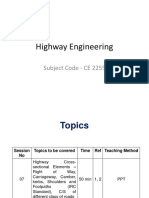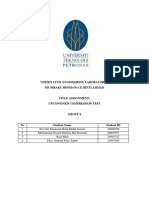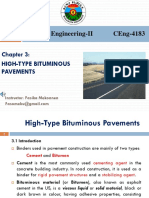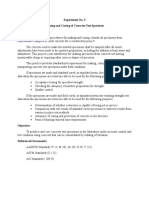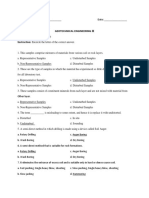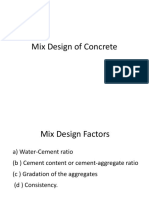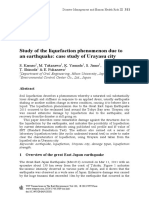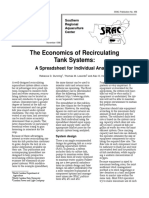Sand Replacement Test Lab Manual
Sand Replacement Test Lab Manual
Uploaded by
mmCopyright:
Available Formats
Sand Replacement Test Lab Manual
Sand Replacement Test Lab Manual
Uploaded by
mmOriginal Description:
Copyright
Available Formats
Share this document
Did you find this document useful?
Is this content inappropriate?
Copyright:
Available Formats
Sand Replacement Test Lab Manual
Sand Replacement Test Lab Manual
Uploaded by
mmCopyright:
Available Formats
INDIAN INSTITUTE OF TECHNOLOGY GANDHINAGAR
Department of Civil Engineering
Soil Mechanics Laboratory
SAND REPLACEMENT (INSITU-DENSITY) METHOD
(IS 2720-PART-28-1974) Reaffirmed-2010
THEORY:
The in-situ density is defined as the bulk density of soil measured at its actual depth. By conducting this test, it
is possible to determine the field density of the soil. The moisture content is likely to vary from time and hence the field
density also. So it is required to report the test result in terms of dry density.
NEED & SCOPE:
This method of test is intended for determining the in-situ density of soils. The apparatus described herein is
restricted to the tests in soils containing particles not larger than 2 in diameter. The in situ density of natural soil is
needed for the determination of bearing capacity of soils, for the purpose of stability analysis of slopes, for the
determination of pressures on underlying strata for the calculation of settlement and the design of underground
structures. It is very quality control test, where compaction is required, in the cases like embankment and pavement
construction.
APPARATUS REQUIRED:
1. Sand pouring Apparatus
2. Standard sand-graded between the No.25 (600 micron) and No.52 (300 micron) B.S. Sieves
3. Soil tray with a central hole
4. Balance of 15kg capacity
5. Sensitive balance accurate to 0.1gm
6. Oven
Miscellaneous equipments such as small pick chisels or spoon for digging test hole, moisture tins.
PROCEDURE:
1. Weight of Sand Occupying the Cone of the Sand Pouring Apparatus
Pour sand into the apparatus with valve closed and determine weight of apparatus and sand (W 1). Place the
apparatus on a smooth glass plate and open the valve to fill the conical portion. After the sand stops running, close the
valve sharply, and weight the remaining sand into the apparatus (W 2). The weight (W1 W2) represents the weight of
sand required to fill the cone of the apparatus. Replace the sand removed in the apparatus.
2. Density of Sand
Fill the Sand Pouring Apparatus with known weight of sand (W3) and place it concentrically on top of the
calibrating cylinder. Open the shutter and allow the sand to drain out. When no further movement of sand takes place in
the apparatus, close the shutter and weight the sand remaining in the apparatus (W4).The weight (W3-W4) represents the
quantity of sand used in filling calibrating cylinder as well as cone of the apparatus.
Now [(W3-W4) (W1 W2)] gives the weight of sand required to fill the calibrating cylinder. Volume (V c) of
the cylinder may be determined either by measuring its internal dimensions or by filling it with water.
Density of sand can be computed using mass of sand filled in cylinder and volume (V c) of the cylinder.
IIT Gandhinagar, Soil Mechanics Lab Page1
INDIAN INSTITUTE OF TECHNOLOGY GANDHINAGAR
Department of Civil Engineering
Soil Mechanics Laboratory
3. Density of Soil
Prepare the surface of the location to be tested so that it is a level plane. Keep the soil tray firmly on the place
surface. Excavate with hand tools a hole with diameter equal to that of the hole of the plate and about 10cm in depth with
smooth walls and rounded bottom edges. Place all loosened soil in a container being careful to avoid losing any material.
Seat the already weighed apparatus with sand on the hole of the tray. Open the valve and after the sand has stopped
flowing close the valve. Weigh the apparatus with remaining sand and determine the weight of sand occupying the
cavity. Weigh the material that was removed from the test hole. Mix the material thoroughly and weigh a representative
sample for moisture determination. Dry and weigh the sample to determine moisture content.
OBSERVATIONS & RECORDINGS:
From the known density of sand and the weight of sand occupying the hole, calculate the volume of hole.
From the weight of the soil scooped out of hole whose volume is now known and the value of moisture content,
calculate the wet and dry density of soil.
i) SAND REPLACEMENT METHOD:
No. Particulars 1 2 3
1. Bulk density of standard Sand gm/cc
2. Weight of Sand pouring apparatus +sand before
Experiment gm
3. Weight of sand pouring apparatus + sand after
Experiment gm
4. Weight of sand drained out gm
5. Weight of sand occupying cone gm
6. Weight of sand occupying cavity gm
7. Volume of cavity
8. Weight of soil scooped out from the cavity gm
9. Wet density gm/cc
10. Moisture content
11. Dry density gm/cc
IIT Gandhinagar, Soil Mechanics Lab Page2
INDIAN INSTITUTE OF TECHNOLOGY GANDHINAGAR
Department of Civil Engineering
Soil Mechanics Laboratory
Moisture Content Percent:
CONTAINER No.:
Wt. of container + Wet Soil gm
Wt. of container + Dry soil gm
Wt. of container gm
Wt. of water gm
Wt. of dry soil gm
Moisture Content in percent
Average Moisture Content of the Soil Layer = percent
Average Dry Density of the Soil Layer = gm/cc
IIT Gandhinagar, Soil Mechanics Lab Page3
You might also like
- Virtues, Vices and Values - The Master List - 2020Document40 pagesVirtues, Vices and Values - The Master List - 2020Andrea Lourdes Di Leo100% (1)
- Determination of Field Density by Core Cutter MethodDocument3 pagesDetermination of Field Density by Core Cutter MethodYogendra Patil100% (1)
- Laboratory Manual On Geotechnical Engineering/Foundation Engineering/Soil Mechanics:Test of SoilDocument18 pagesLaboratory Manual On Geotechnical Engineering/Foundation Engineering/Soil Mechanics:Test of SoilSantosh KumarNo ratings yet
- Chapter 3Document41 pagesChapter 3Muhammad Farhan GulNo ratings yet
- Application of Multilinear Regression Analysis in Modeling of Soil Properties For Geotechnical Civil Engineering Works in Calabar SouthDocument7 pagesApplication of Multilinear Regression Analysis in Modeling of Soil Properties For Geotechnical Civil Engineering Works in Calabar SouthMasood AhmedNo ratings yet
- Asphalt PavingDocument14 pagesAsphalt Pavingmido_20067581No ratings yet
- Highway Engineering: Subject Code - CE 2255Document43 pagesHighway Engineering: Subject Code - CE 2255HanafiahHamzahNo ratings yet
- Lab Report Unconfined Compression TestDocument9 pagesLab Report Unconfined Compression TestdiyaNo ratings yet
- Density For Soil by Sand Displacement Method: Scope Is Code ApparatusDocument2 pagesDensity For Soil by Sand Displacement Method: Scope Is Code ApparatusMastani BajiraoNo ratings yet
- Making and Curing Concrete Test Specimens in The Laboratory: Experiment No. 6Document4 pagesMaking and Curing Concrete Test Specimens in The Laboratory: Experiment No. 6Mark Anthony Estoque Dusal0% (1)
- Geotechnical Engineering 1Document4 pagesGeotechnical Engineering 1Christy Mae LabajoNo ratings yet
- Assignment Solutions 5Document5 pagesAssignment Solutions 52020CEM029 MUJEEBUL100% (1)
- Tunneling in Soft StrataDocument8 pagesTunneling in Soft StrataPooja RautNo ratings yet
- Lab 11 - CBR TestDocument9 pagesLab 11 - CBR Testnabil mahadzirNo ratings yet
- Classification of Soil-150804095426-Lva1-App6892 PDFDocument23 pagesClassification of Soil-150804095426-Lva1-App6892 PDFHaryo ArmonoNo ratings yet
- DPP 1Document32 pagesDPP 1ShubhamNo ratings yet
- Plastic Limit Lab ReportDocument6 pagesPlastic Limit Lab ReportPeter KamauNo ratings yet
- California Bearing Ratio Test: 1. ObjectiveDocument3 pagesCalifornia Bearing Ratio Test: 1. ObjectiveVickyNo ratings yet
- Plastic Limit TestDocument9 pagesPlastic Limit TestWilmer FernandezNo ratings yet
- Part III C) Vertical AlignmentDocument41 pagesPart III C) Vertical AlignmentAlemayehu Miteku100% (1)
- Hand AugerDocument8 pagesHand AugerGerald TanNo ratings yet
- Highway Lab ReportDocument9 pagesHighway Lab Reportcarlton0878% (9)
- Field Density of Soil by Rubber Balloon Method PDFDocument6 pagesField Density of Soil by Rubber Balloon Method PDFkaushik arunexcelloNo ratings yet
- 2 Determination of in Place Field Soil Density by Using Sand Cone MethodDocument5 pages2 Determination of in Place Field Soil Density by Using Sand Cone MethodGintoki100% (1)
- PrincGeoEng 10e Ch06 PowerPointDocument26 pagesPrincGeoEng 10e Ch06 PowerPointHarambe GorillaNo ratings yet
- Bulk Density and Voids in AggregatesDocument3 pagesBulk Density and Voids in AggregatesJohn Reigh CatipayNo ratings yet
- Moving Observer MethodDocument7 pagesMoving Observer MethodNouman QuraishiNo ratings yet
- COMPACTION OF SOILS (Loiza)Document2 pagesCOMPACTION OF SOILS (Loiza)Loiza Joi MulanoNo ratings yet
- Direct Shear Test ReprtDocument4 pagesDirect Shear Test ReprtShivaraj SubramaniamNo ratings yet
- Angularity Number Test: Sushrut Gautam KCE074BCE089 Transportation Engineering II Khwopa College of EngineeringDocument5 pagesAngularity Number Test: Sushrut Gautam KCE074BCE089 Transportation Engineering II Khwopa College of EngineeringSushrutNo ratings yet
- Ce1305 - Foundation Engineering: 2 Marks Questions & Answers 16 Marks QuestionsDocument13 pagesCe1305 - Foundation Engineering: 2 Marks Questions & Answers 16 Marks QuestionsRaguram pNo ratings yet
- P&B m1Document5 pagesP&B m1Andrizal ChaidarNo ratings yet
- Experiment No. 7 Bulking of SandDocument1 pageExperiment No. 7 Bulking of SandShubham GautamNo ratings yet
- Triangulation Quadrilateral - Field Survey ExperimentDocument7 pagesTriangulation Quadrilateral - Field Survey ExperimentGowtham AmirNo ratings yet
- Item 104Document28 pagesItem 104Wilbert Carlo RachoNo ratings yet
- Grain Size Analysis by Wet and Dry Sieve Analysis: 1. ObjectiveDocument4 pagesGrain Size Analysis by Wet and Dry Sieve Analysis: 1. ObjectiveMuhammad AfrasiyabNo ratings yet
- Chapter 3-High-Type - Bituminous - PavementsDocument49 pagesChapter 3-High-Type - Bituminous - PavementsAbel MulugetaNo ratings yet
- PP2-Execution Methodology of Flexible PavementDocument45 pagesPP2-Execution Methodology of Flexible PavementSrinivas PNo ratings yet
- CMT Lab. 03Document5 pagesCMT Lab. 03John Ceasar PascoNo ratings yet
- Aggregate Impact ValueDocument8 pagesAggregate Impact ValueAnis Nurfarahanim Abdul HalimNo ratings yet
- Soil Compaction Test: Insitu Density Test Using Sand Cone Replacement MethodDocument3 pagesSoil Compaction Test: Insitu Density Test Using Sand Cone Replacement MethodHu DaNo ratings yet
- Civil Engg Materials Lab ManualDocument34 pagesCivil Engg Materials Lab ManualAli RazaNo ratings yet
- Quiz For Foundation - Answer KeyDocument3 pagesQuiz For Foundation - Answer KeyGie Andal100% (1)
- Aggregate Impact ValueDocument4 pagesAggregate Impact ValueIkhwan Z.100% (1)
- Prob Set 3Document2 pagesProb Set 3John Carlo GalangNo ratings yet
- Mix Design of Concrete-IS MethodDocument26 pagesMix Design of Concrete-IS MethodashoknrNo ratings yet
- Ejemplos Axial Flexion PorteusDocument28 pagesEjemplos Axial Flexion PorteusPablo CartagenaNo ratings yet
- SSD and PSD (FOSD)Document22 pagesSSD and PSD (FOSD)Theyen NaidooNo ratings yet
- Te2 Module 6 Te2 Module 6te2 Module 6te2 Module 6te2 Module 6te2 Module 6Document5 pagesTe2 Module 6 Te2 Module 6te2 Module 6te2 Module 6te2 Module 6te2 Module 6Mark Arboleda Gumamela0% (1)
- Theory Costant Head MethodDocument4 pagesTheory Costant Head MethodsyathirohNo ratings yet
- Determination of Liquid and Plastic Limits of Soil SampleDocument7 pagesDetermination of Liquid and Plastic Limits of Soil SampleGaurav MallaNo ratings yet
- Stripping ValueDocument3 pagesStripping ValueYasirNo ratings yet
- Geogrid As A Soil Reinforcement": Seminar On-"Document31 pagesGeogrid As A Soil Reinforcement": Seminar On-"sayedNo ratings yet
- Hydrometer TestDocument2 pagesHydrometer Testshikar marmarNo ratings yet
- Experiment 7: Field Density (Sand Cone Method)Document8 pagesExperiment 7: Field Density (Sand Cone Method)Thanaa' Marabeh100% (1)
- CBR Test Procedure Determination of California Bearing Ratio For Road Design PDFDocument5 pagesCBR Test Procedure Determination of California Bearing Ratio For Road Design PDFMohamed AdelNo ratings yet
- Aashto t191 Density in Place by The Sand Cone Method PDFDocument6 pagesAashto t191 Density in Place by The Sand Cone Method PDFdonyNo ratings yet
- GeopipesDocument9 pagesGeopipesRamesh GhaleNo ratings yet
- Flow Table Test For Fresh ConcreteDocument3 pagesFlow Table Test For Fresh ConcreteYasirNo ratings yet
- Numerical Methods and Implementation in Geotechnical Engineering – Part 1From EverandNumerical Methods and Implementation in Geotechnical Engineering – Part 1No ratings yet
- SAND REPLACEMENT TEST Lab Manual PDFDocument3 pagesSAND REPLACEMENT TEST Lab Manual PDFRobinson Tara TangkesaluNo ratings yet
- Civil Soil Liquefaction ReportDocument32 pagesCivil Soil Liquefaction Reportمحمد عبدالرازق عبدالله50% (2)
- Ayothiraman2012 PDFDocument12 pagesAyothiraman2012 PDFmmNo ratings yet
- Ayothiraman2012 PDFDocument12 pagesAyothiraman2012 PDFmmNo ratings yet
- Assignment 3 Bearing CapacityDocument1 pageAssignment 3 Bearing CapacitymmNo ratings yet
- Financial Terms and ConditionDocument1 pageFinancial Terms and ConditionmmNo ratings yet
- NII-Electronic Library ServiceDocument19 pagesNII-Electronic Library ServicemmNo ratings yet
- Select Liquefaction Case Histories From The 2010-2011 Canterbury Earthquake SequenceDocument23 pagesSelect Liquefaction Case Histories From The 2010-2011 Canterbury Earthquake SequencemmNo ratings yet
- Liquefaction Hazard Zonation For The City of BhujDocument13 pagesLiquefaction Hazard Zonation For The City of BhujmmNo ratings yet
- Civil Engineering Seminar Topics - Soil LiquefactionDocument13 pagesCivil Engineering Seminar Topics - Soil LiquefactionmmNo ratings yet
- Welcome All.!Document32 pagesWelcome All.!mmNo ratings yet
- Liquefaction:: A Major Cause of Structural Failure During EarthquakeDocument34 pagesLiquefaction:: A Major Cause of Structural Failure During EarthquakemmNo ratings yet
- Seismic Soil Liquefaction Based On in Situ Test Data: IGC 2009, Guntur, INDIADocument8 pagesSeismic Soil Liquefaction Based On in Situ Test Data: IGC 2009, Guntur, INDIAmmNo ratings yet
- LiquefactionDocument21 pagesLiquefactionmmNo ratings yet
- 113 119 PDFDocument7 pages113 119 PDFmmNo ratings yet
- Implementation of Finite Element Method For Prediction of Soil Liquefaction Around Undergroud StructureDocument12 pagesImplementation of Finite Element Method For Prediction of Soil Liquefaction Around Undergroud StructuremmNo ratings yet
- Study of The Liquefaction Phenomenon Due To An Earthquake: Case Study of Urayasu CityDocument12 pagesStudy of The Liquefaction Phenomenon Due To An Earthquake: Case Study of Urayasu CitymmNo ratings yet
- Evaluation of Some Geotechnical Properties and Liquefaction Potential From Seismic ParametersDocument16 pagesEvaluation of Some Geotechnical Properties and Liquefaction Potential From Seismic ParametersmmNo ratings yet
- Assignment 7 PDFDocument2 pagesAssignment 7 PDFmmNo ratings yet
- The SEBI Was Established in 1988 But Was Only Given Regulatory Powers On April 12, Board of India Act, 1992Document13 pagesThe SEBI Was Established in 1988 But Was Only Given Regulatory Powers On April 12, Board of India Act, 1992Bishal RoyNo ratings yet
- Anatomi Kinesiologi Pergelangan Kaki Dan KakiDocument38 pagesAnatomi Kinesiologi Pergelangan Kaki Dan KakiGhea Putri HendrianiNo ratings yet
- Two Wheeler Standalone OD Only: Certificate of Insurance Cum Policy ScheduleDocument3 pagesTwo Wheeler Standalone OD Only: Certificate of Insurance Cum Policy ScheduleMohd UvaisNo ratings yet
- Buddhist PhenomenologyDocument50 pagesBuddhist PhenomenologySergiusz WoźnickiNo ratings yet
- Soal Semester Ganjil X 2023Document14 pagesSoal Semester Ganjil X 2023AnnadiahNo ratings yet
- Scientific Physical Training - Indian Clubs - WarmanDocument100 pagesScientific Physical Training - Indian Clubs - Warmantree-harvest100% (3)
- Cross Currents. The Perils of Electropollution. The Promise of Electromedicine (Robert O. Becker)Document361 pagesCross Currents. The Perils of Electropollution. The Promise of Electromedicine (Robert O. Becker)vjcikes100% (2)
- Maytag MAV2755AWW Washer Use and Care Guide enDocument52 pagesMaytag MAV2755AWW Washer Use and Care Guide enRichard RoperNo ratings yet
- Bo International Essential OilsDocument14 pagesBo International Essential OilsBipinNo ratings yet
- General Plot Plan Development PhilosophyDocument5 pagesGeneral Plot Plan Development Philosophykrunal panchalNo ratings yet
- Inspection and Test Plan For SwitchgearDocument12 pagesInspection and Test Plan For SwitchgearShahadat HossainNo ratings yet
- MODULE 4 - ActivityDocument5 pagesMODULE 4 - ActivityEricka Mae AbreaNo ratings yet
- The Economics of Recirculating Tank Systems, A Spreadsheet FDocument8 pagesThe Economics of Recirculating Tank Systems, A Spreadsheet FEuclides CagniniNo ratings yet
- Ending Discrimination Against People With Mental and Substance Use Disorders: The Evidence For Stigma ChangeDocument171 pagesEnding Discrimination Against People With Mental and Substance Use Disorders: The Evidence For Stigma ChangeJose Fernandez MNo ratings yet
- Effectiveness of Supportive Therapy 21-27 PDFDocument7 pagesEffectiveness of Supportive Therapy 21-27 PDFIndian Journal of Psychiatric Social WorkNo ratings yet
- Pizzaexpress Menu Tre TaDocument2 pagesPizzaexpress Menu Tre TaOliver TillNo ratings yet
- English Exercises Modals - Should, Would, CouldDocument1 pageEnglish Exercises Modals - Should, Would, CouldYasureth NavarroNo ratings yet
- Bro69626 - FM - I-Xxvi - Indd 1 10/15/18 11:49 AMDocument45 pagesBro69626 - FM - I-Xxvi - Indd 1 10/15/18 11:49 AMpuspipuspita358No ratings yet
- SCHEDULECIVILR1Document86 pagesSCHEDULECIVILR1kathiravanNo ratings yet
- WS IV - 3 Kasus Dari Dr. Tjan Sian - Six Sigma KOnas Case Study FINALDocument24 pagesWS IV - 3 Kasus Dari Dr. Tjan Sian - Six Sigma KOnas Case Study FINALMustakim DuharingNo ratings yet
- Assessment of Fracture Risk and Its Application To Screening For Postmenopausal Osteoporosis Synopsis of A WHO ReportDocument14 pagesAssessment of Fracture Risk and Its Application To Screening For Postmenopausal Osteoporosis Synopsis of A WHO ReportKhủngLongSiêuNguyHiểmNo ratings yet
- ECON311 Analysis 5Document5 pagesECON311 Analysis 5Ryota kiseNo ratings yet
- Valves 2017-18Document59 pagesValves 2017-18Sethu MadhavNo ratings yet
- Manual de Usuario Dacia Sandero (2011) (238 Páginas) 3Document2 pagesManual de Usuario Dacia Sandero (2011) (238 Páginas) 3Ignacio VillarNo ratings yet
- Training PODFA: Mechanical Maintenance of Preheater and KilnDocument164 pagesTraining PODFA: Mechanical Maintenance of Preheater and KilnДен Стаднік100% (1)
- McMURDO MT1 Installation ManualDocument61 pagesMcMURDO MT1 Installation ManualANDREASBOULNo ratings yet
- PPD Laboratories Central Lab InfographicDocument1 pagePPD Laboratories Central Lab InfographicMalik AlnabhaniNo ratings yet
- Free Fusion Reiki Attunement Leaflet: Who Is Rev Jason Storm?Document5 pagesFree Fusion Reiki Attunement Leaflet: Who Is Rev Jason Storm?Leandro Arce100% (1)
- FORTUNE ACCOUNTS - KERICHODocument35 pagesFORTUNE ACCOUNTS - KERICHOtowettNo ratings yet






